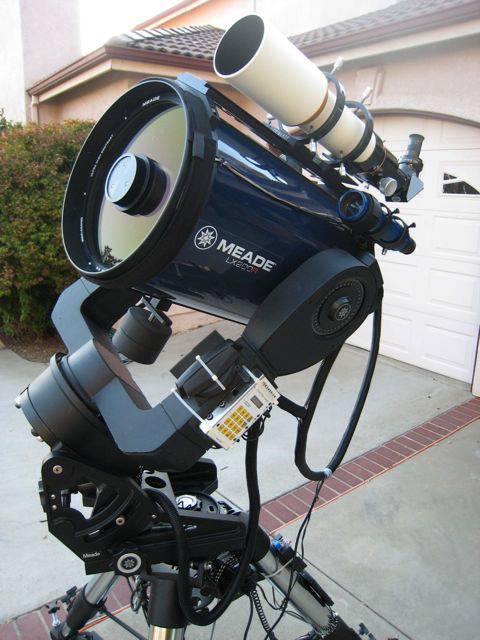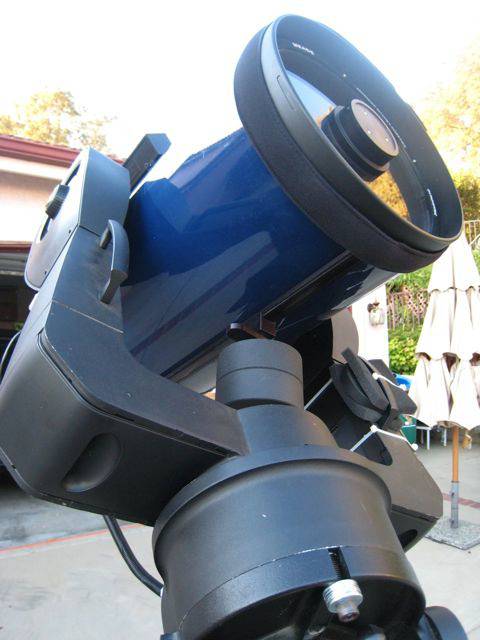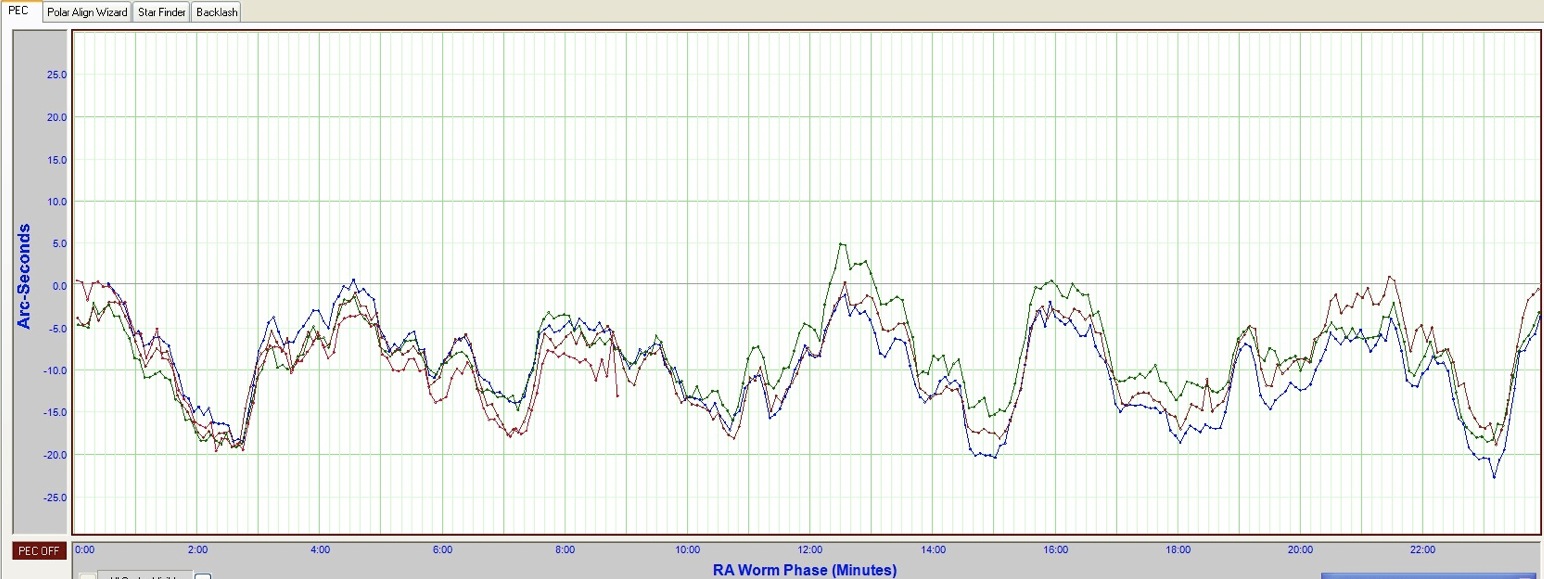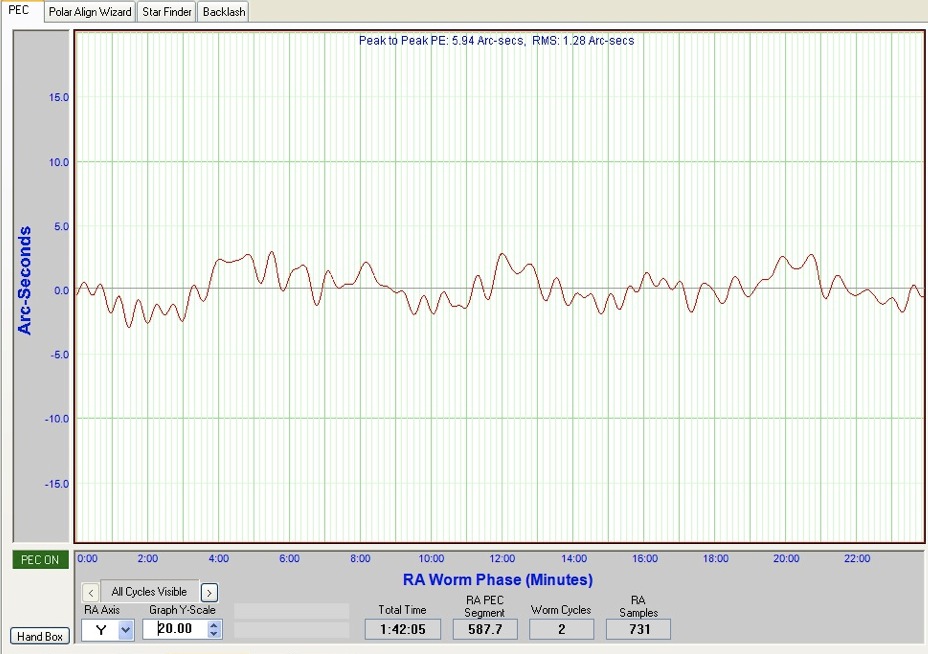

The Meade Instrument Corporation ("Meade") LX200 Schmidt Cassegrain telescopes have been a staple of amateur astronomers for the past 3-4 decades, competing directly with Celestron. Both Meade and Celestron utilize fork mounts which are included with their Schmidt-Cassegrain Telescope (SCT) systems. These can be either used in an alt-az (altitude-azimuth) mode, on a tripod or pier, or may be mounted equatorially (as shown above) on a wedge. I used the Meade UltraWedge, which is quite robust - a step up from their "SuperWedge". Some additional views of the LX200 on the UltraWedge are shown below: |
  |
The Meade LX200 comes in several different sizes, including 8", 10", 12" and 14" (these are the nominal diameters of the primary mirror); therefore, theforks are made specifically for each of these scopes. I originally had the 10" LX200SMT, and then upgraded to the 12" LX200R (ACF) - however, both of these scopes had very similar mounts, controlled by the AutoStar system. The bases of these scopes are compatible, so can be placed on any of the wedges or tripods made by Meade or 3rd parties (Mitty, Milburn, APT, etc.). The Meade UltraWedge is shown below. Basically a wedge is used to tilt the telescope at an angle (relative to vertical) equal to the lattitude where the telescope is located. This puts the RA axis parallel to the earth's axis of rotation, allowing the scope to track stars and other objects, making them appear 'still' at the CCD camera (because the scope is rotating at the same speed as the earth). The controls on the wedge are used to polar align the scope - they adjust the azimuth (horizontal direction) and altitude (vertical angle) of the scope. |
  |
The wireless version of the AutoStar controller is shown below; this handpiece has a large database of stars and celestial objects, stores the periodic error correction ("PEC") data, and displays scope position and other parameters. The EPROM in the AutoStar controller can be updated with additional objects (e.g., satellites, comets) and tours. |
 |
Using tPoint modeling software, I was able to get pointing accuracies in the range of 3-5 arcminutes using the LX200 mount; potentially, using a better tPoint model, this could be reduced (probably to the range of 2-3 arcminutes). While this pointing accuracy isn't great, it is good enough to 1) put objects on a relatively small CCD chip, and 2) get within the range that a plate solve can then provide fine correction to the mount (in an automated set-up, such as using CCDAutoPilot). Unfortunately, I had not learned about tPoint modeling at the time I owned the LX200 mount, so I indiscriminantly included modeling terms that were inappropriate -leading to relatively "good" RMS pointing, but resulting in terrible fine-pointing. For example, I could ask the scope to center an object that is 2 arcminutes off-center, and end-up with the mount going 5 arcminutes in the wrong direction! However, I have no doubt that proper tPoint modeling of the LX200 will allow relatively good pointing accuracy, as well as correct object centering. Using PemPro, I measured and corrected the periodic error of the LX200 mount. Uncorrected, the LX200 showed about 20-25 arcsecond periodic error (peak-to-peak, roughly); after measuring several cycles of the periodic error and developing a good PemPro model, the periodic error could be reduced to 5-6 arcseconds peak-to-peak. This is respectable, considering the very low price of the mount (the entire 10" or 12" scope sells new for $3-5K, which includes the mount, the OTA and accessories - so the mount itself probably has a new value of about $1000-1500). The seeing in most accessible U.S. locations is typically 2 arcseconds or higher, which means that the LX200 pointing is about 3-4x the seeing; depending on the camera pixel size, the periodic error can be of the order 10-12 pixels on the final image (e.g., with 7-9 micron pixels, at the native 3000 mm focal length of the 12" LX200 scope). Uncorrected and corrected periodic error curves for the 12" LX200 scope, as measured by PemPro, are shown below: |
 |
 |
|
Overall, the LX200 mount provides reasonably decent performance at a very low price - compared with stand-alone high-quality mounts. For comparison, some of the current great mounts include the Paramount ME (sells used for around $10-12K), the AstroPhysics 1200 (sells used for around $9.5-11.5K), the AstroPhysics 900 (sells used for around $6.5K-8.5K), the AstroPhysics Mach1 (around $5.5K), the Takahashi EM400 (around $6K), Takahashi NJP (around $5K), Takahashi EM200 (around $4.5K). There are, of course, mounts selling in the $2-3K range, but they typically have limited payload specifications; even my 12" LX200R system - when loaded-up with camera, rotator, focuser, 3D counterweights, dew system, and short refractor (with Losmandy rails, rings, etc.) - weighed 70-80 lbs (35-40 Kg). So this system would actually need the capability of an AP1200, Paramount ME, or EM500 class mount. Of all the components in an astro-imaging system, the mount is probably the most important, and should be over-sized for the scope and camera system (etc.) being carried. My Paramount ME is capable of carrying 150 lbs of payload (plus 150 lbs of counterweights), and my scopes and imaging equipment probably weigh around 90-100 lbs. Even larger mounts are now becoming available for very large amateur set-ups - including the AstroPhysics 3600, the Planewave Ascension 200, and the Chronos "harmonic drive" mounts. |
Meade LX200 series telescope mount for astro-imaging astrophotography observatory scope platform described specifications provided |